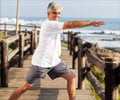Your need to hit the gym heightens as the benefits of exercise gets increasing day by day. Exercise can actually speed up wound healing process.

‘Regular exercise plays a critical role in helping muscles repair themselves as quickly as possible after injury.’





"Exercise pre-conditioning may improve the muscle repair response in older adults to stimuli such as acute periods of atrophy/inactivity and/or damage," said Gianni Parise, a researcher involved in the work and Associate Professor in the Department of Kinesiology at McMaster University in Hamilton, Ontario, Canada.
"Exercise-conditioning rescues delayed skeletal muscle regeneration observed in advanced age." The study was published in the The FASEB Journal.
To make this discovery, Parise and colleagues used three groups of mice: old mice that were exercise trained, old mice that were not exercise trained, and young mice that were not exercised trained. In the first group, old mice were trained three days/week for eight weeks. The effect of exercise in aging muscle was measured by comparing the three groups of mice. Changes in muscle repair with aging were determined by injecting the old mice and young mice (neither group exercised) with snake venom commonly used to induce muscle injury in rodent studies. These mice were compared prior to muscle injury, 10 days following injury and 28 days following injury.
"This is a clean demonstration that the physiological and metabolic benefits of exercise radiate to skeletal muscle satellite cells, the adult stem cells responsible for repair after injury, even in senescent animals," said Thoru Pederson, Editor-in-Chief of The FASEB Journal. "Strikingly, even as the contractile elements of muscle tissue wane with age, the capacity of the satellite cells to respond to exercise cues is maintained. This aging-resistant retentive property could be added to the list of features that define adult stem cells," he added.
Source-Eurekalert















